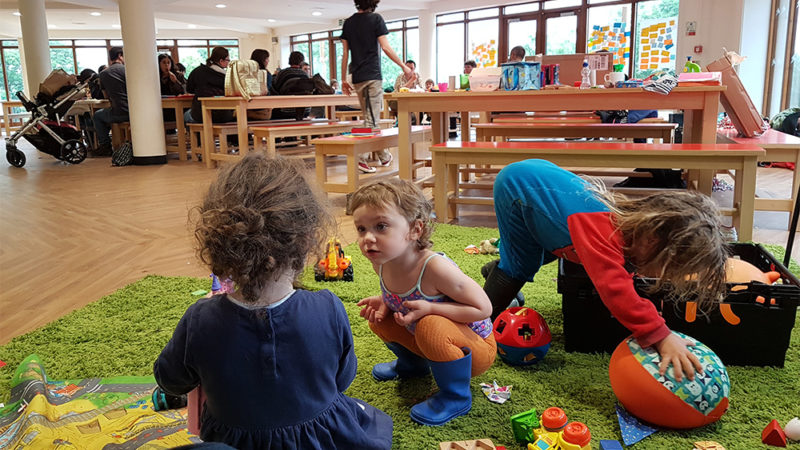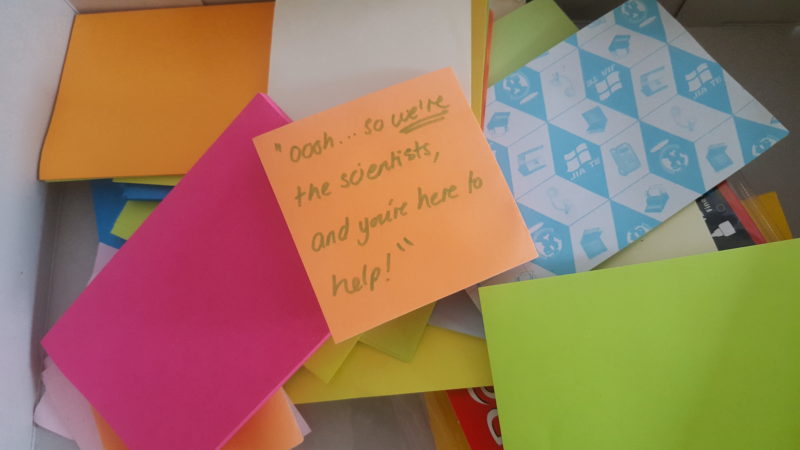
Top tips on being family-friendly
In this blogpost you’ll find our top tips on engaging parents online and at face-to-face events.
The golden rule of public engagement is to know your audience, and if you want to get parents involved, then you need to cater for the whole family.
Online
Regular engagement requires minimising the effort of getting involved. Going to where your participants are, not making them come to you, is essential. Facebook is great for that, it’s where many mums hang out for their downtime, in the evening, while breastfeeding for hours, while kids are playing etc and can be used on a phone (doesn’t need computer).
“It being on Facebook made it really accessible”
The advantages of Facebook extended beyond familiarity.
- Privacy settings of groups enables discussion to be private so that members discussing more sensitive subjects can be confident that their comments can’t be viewed by their wider social networks or the public.
- Members can interact non-simultaneously – a comment made in the morning by one person can be interacted with throughout the day by others.
However, as Facebook doesn’t show users all content, schedule regular reminders about everything. This also supports those with extremely busy home and work lives, for whom an extra reminder means one less thing to have to remember!
Text-based activities are important to members with small children as they can engage with tasks while feeding or while sitting with a child as they fell asleep without disturbing the child or the need for headphones.
Keep posts short. These display well on phones and, busy parents can read them quickly when they have a few minutes to spare. Break down complex processes into small, simple to understand chunks, so that members can respond quickly and fit tasks in between work and family commitments. Don’t hop between online platforms. By and large, we kept the whole project on Facebook, very occasionally using other platforms (e.g. Google Drive for documents), when it was unavoidable. We found that pretty much any extra clicks – especially moving to an unfamiliar platform – reduced engagement. Initially we trialled Q&As in a chat room on another site, but members overwhelming voted for the familiarity of Facebook.
Timing
9pm is a great time for parents (though some might be drifting off to sleep!). We decided to run our Q&A sessions live so that members thoughts could bounce off each other and natural conversations could develop with the expert. We discussed the timing of these sessions with our members and concluded that despite families’ very different schedules, 9pm was the best time, after most children had gone to bed. In general, experts were happy to join us in the evenings and the only major problems we encountered were with experts from Australasia, for whom it was a pretty early start (7am).
Face-to-face events
Designing events that fit in with parents’ busy lives is a real challenge. We quickly recognised that mothers are often bottom of the pecking order in a household – a child’s party can trump a previously arranged mother-centred activity.
Stay as flexible as possible about people dropping out and adding new people fairly close to the deadline.
Make your event rank highly in a family’s calendar by providing something exciting for everyone. Our events that included organised science activities for kids were better attended than those that just provided child care. Kids were excited about coming and so parents were more able to prioritise getting there.
Choose your venues carefully to cater for families rather than conferences. As well as the usual accessibility considerations think about
- Acoustics (lots of kids equals lots of noise)
- Distance to bedrooms (little kids need naps)
- Baby changing facilities (some kids need quiet for a mess-free change)
- Space for storing buggies (they are massive and often muddy/wet)
- Flooring in eating areas (kids make a mess)
- Flexibility in food content and timings (kids will often sleep through a meal time)
Don’t underestimate the impact of food allergies. Make sure your catering company provides accurate information well in advance and can work with specific needs. Have really clear communication with parents who are affected by this.
Make it easy for busy parents to access detailed information about the whole event and venue. Post regularly on Facebook with the most important pieces of information and provide a full info pack really early on with detailed agendas and travel info. Provide excessively detailed travel info – busy parents don’t have time to spend looking for bus services or working out what stop to get off at. Our participants thanked us for providing photos of bus stops, car parks and the route to venues.
In online projects, members have often never met each other and may feel apprehensive about meeting up in real life. Set up Facebook groups for them to chat informally about the event so that they have an idea of people that they are going to meet. Nervous people don’t like surprises – make sure the agenda is clear about the sort of activities that might occur. An idle comment about bringing wellies (just in case it rains and you want to keep your feet wet while walking between buildings), can result in panic to those who fear crazy team-building activities!
Construct your agenda so that it is really flexible and can cope with participants being absent for sessions (while they calm an upset child, or stay with a sleeping child).
Make an effort to include accompanying adults to look after members’ children and give them lots of information about what is happening. Be aware that some accompanying adults may not be used to having to look after kids without support of their parent and may be surprised not to be involved in the “work” of the event. They need to feel that their contribution as a carer is valued and essential to the project. Information pack about the event, venue and things to do nearby (for those who don’t want to hang out with other families) are always well received.
Provide free, high-quality childcare at all events for those who can’t bring an additional adult to care for children. But be prepared for the numbers of children to vary dramatically and keep updating the childcare providers so that they are prepared for the group’s different needs.
Always welcome children into the working area so that mothers can feed them, but make sure something more interesting is happening elsewhere so that mobile children are keen to get back to the fun. Regular, kid-friendly snacks mean that children are less likely to need input from a parent.
Have your child-care and kids’ activities close enough to the main activity so that the child can visit the parent quickly if necessary and so that breastfed children can access their mother. But don’t have them too close! If kids can see their parent, then they will want to come and play with them. Avoid windows between the two areas.
Most importantly, keep everything really informal and model that it’s okay for your kids to have disrupted your sleep/morning/life and that you can still be respected as an intelligent person. Acknowledge caring for kids as integral to the lives of your participants. It is just as normal as needing toilet facilities or regular meals.
